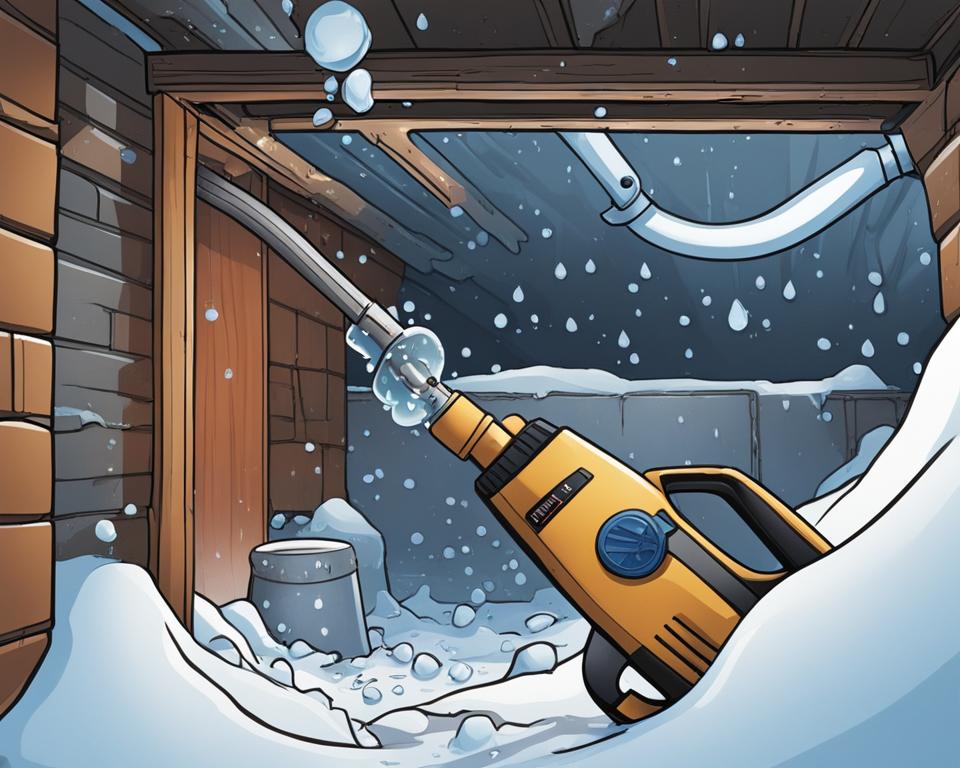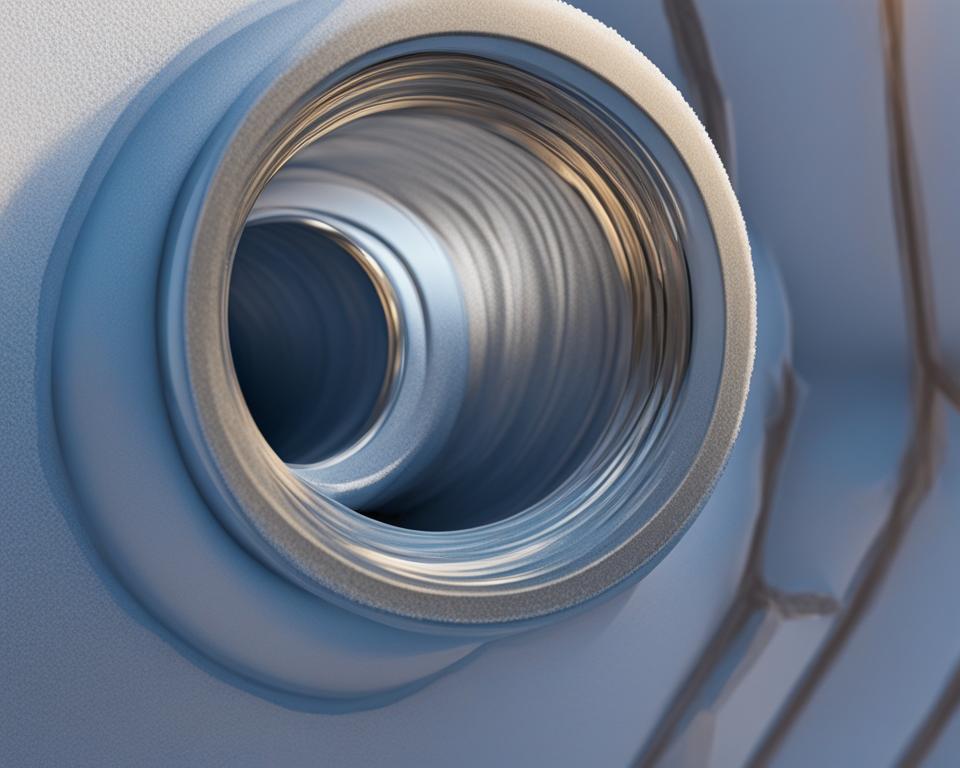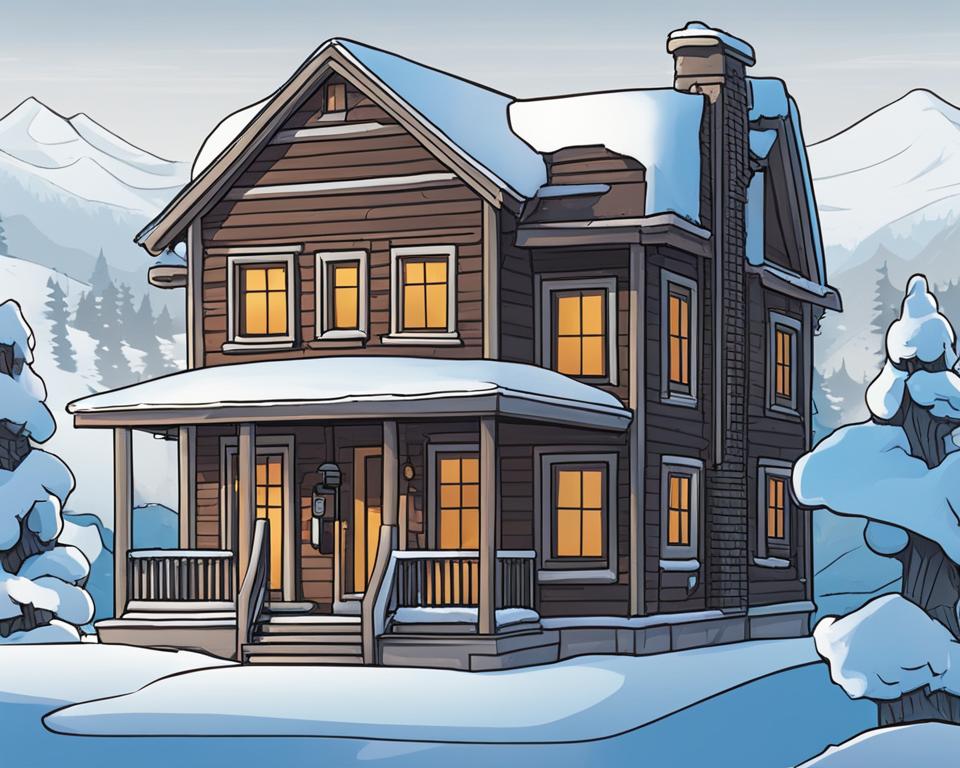Welcome to our comprehensive guide on preventing frozen pipes. As the temperatures drop, it’s essential to take proactive steps to protect your plumbing system from potential damage. Frozen pipes can lead to leaks, bursts, and costly repairs. By implementing the following preventive measures, you can ensure that your pipes remain safe and functioning throughout the winter season.
Key Takeaways:
- Keep your garage doors closed to prevent cold air from affecting any water supply lines.
- Open kitchen and bathroom cabinet doors to allow warm air to circulate around plumbing located on exterior walls.
- Let cold water drip from a faucet served by exposed pipes to prevent freezing.
- Maintain a consistent thermostat temperature during the day and night.
- Leave the heat on in your home, set to a temperature no lower than 55°F, if you plan to be away during cold weather.
Insulating Pipes and Other Winter Prep Steps
As the winter season approaches, taking steps to insulate your pipes can help prevent freezing and avoid costly damage. Not only can insulating pipes provide an extra layer of protection, but there are also other essential winter prep steps you can take to ensure your plumbing system stays in optimal condition.
Insulating Pipes
Insulating pipes located in vulnerable areas such as attics and crawl spaces is crucial. By wrapping them with pipe insulation, heat tape, or heat cables, you can help maintain a stable temperature and prevent freezing. It’s important to carefully follow the manufacturer’s instructions when installing insulation to ensure it is done correctly.
Sealing Cracks and Openings
In addition to insulating pipes, it’s important to seal any cracks or openings where cold air could enter your home. This is especially important for areas where pipes run from the inside to the outside, as these are vulnerable to freezing. By caulking these gaps, you can help minimize the risk of frozen pipes.
Other Winter Prep Steps
Aside from insulating pipes, there are other steps you can take to prepare your plumbing system for winter. Disconnecting outdoor garden hoses and using faucet covers for outdoor faucets with cut-off valves can help protect them from freezing. Additionally, starting a small drip of hot and cold water in various faucets throughout your home when cold weather is expected can keep the water flowing and prevent freezing.
| Winter Prep Steps | Benefits |
|---|---|
| Insulating pipes | Provides an extra layer of protection against freezing |
| Sealing cracks and openings | Minimizes the risk of frozen pipes |
| Disconnecting outdoor garden hoses | Prevents outdoor faucets from freezing |
| Using faucet covers | Protects outdoor faucets with cut-off valves |
| Starting a small drip of hot and cold water | Keeps water flowing and prevents freezing |
By taking these winter prep steps, including insulating pipes, sealing cracks, and disconnecting outdoor hoses, you can safeguard your plumbing system from freezing and avoid potential damage. Remember, prevention is key when it comes to protecting your pipes during the winter months.
Thawing Frozen Pipes
If you discover frozen pipes in your home, it’s important to take immediate action to thaw them quickly and safely. Here are some effective methods you can use:
- Turn on the faucet: Start by turning on the faucet connected to the frozen pipe. Running water will help melt the ice faster and relieve pressure within the pipe.
- Apply heat: For exposed pipes, you can use a heating pad, a hairdryer on high heat, or heated and dampened towels wrapped around the pipe. You can also position a space heater to circulate warm air around the frozen area. Remember to move the heat source around the pipe as needed.
- Increasing heat: If the frozen pipes are enclosed in a wall or hard-to-reach area, you can try increasing the heat in your home to raise the temperature around the affected area. Alternatively, you may need to cut out a section of the wall to access the pipe for thawing.
It’s important to avoid using extreme heat or open flames such as a blowtorch or propane heater to thaw frozen pipes. These methods can be unsafe and may cause damage to the pipe.

Thawing frozen pipes can help prevent further damage and restore water flow in your home. If you’re unsure about how to thaw the pipes or if the frozen area is difficult to access, it’s best to contact a professional plumber for assistance. They have the knowledge and specialized tools to safely thaw the pipes and address any underlying issues.
Why Pipes Freeze and How to Protect Them
Understanding the causes of frozen pipes is crucial in taking the necessary steps to protect them. When water freezes, it expands, exerting immense pressure on the pipes and increasing the risk of breaks. Several factors contribute to pipe freezing, including exposure to severe cold, unheated interior areas such as basements and crawl spaces, and pipes running against exterior walls with little insulation.
To safeguard your pipes from freezing, there are several measures you can take. Start by draining water from swimming pool and sprinkler supply lines, removing and storing outdoor hoses, and closing inside valves supplying outdoor hose bibs. Adding insulation to attics, basements, and crawl spaces is also essential for long-term protection. Consider installing pipe sleeves or UL-listed heat tape on exposed water pipes, and relocating exposed pipes for increased security.
Table: Factors Leading to Pipe Freezing
| Factors | Impact |
|---|---|
| Exposure to severe cold | Increased risk of freezing due to low temperatures |
| Unheated interior areas | Pipes in basements and crawl spaces are vulnerable to freezing |
| Pipes running against exterior walls | Little insulation leads to susceptibility to freezing |
Protecting your pipes from freezing not only prevents costly damage but also ensures a continuous and uninterrupted water supply during the winter months. By following these preventive measures, you can avoid the inconvenience and potential hazards associated with frozen pipes, safeguarding your home and preserving the integrity of your plumbing system.

Conclusion
Protecting your pipes during the winter months is crucial to avoid costly damage. By implementing the strategies outlined in this guide, you can effectively prevent pipes from freezing and ensure your home stays safe and secure.
Insulating pipes, sealing cracks, and maintaining a consistent thermostat temperature are just a few of the winter pipe protection solutions you can employ. Additionally, allowing cold water to drip from a faucet and being prepared to safely thaw frozen pipes are important measures to take.
By taking these preventative steps and staying proactive, you can mitigate the risks associated with frozen pipes and enjoy a worry-free winter season. Remember, a little preparation goes a long way in safeguarding your home and ensuring the uninterrupted flow of water throughout the cold weather.
FAQ
How can I prevent pipes from freezing?
To prevent pipes from freezing, you can keep your garage doors closed, open kitchen and bathroom cabinet doors, let cold water drip from a faucet served by exposed pipes, keep the thermostat set to the same temperature, and insulate attics, basements, and crawl spaces. Additionally, sealing cracks and openings around windows, doors, and the foundation can help prevent drafts.
How do I insulate pipes and prepare for winter?
To insulate pipes, you can wrap them with pipe insulation, heat tape, or heat cables. It’s important to follow the manufacturer’s directions when installing insulation. Other winter prep steps include disconnecting outdoor garden hoses, using faucet covers for outdoor faucets, and starting a small drip of hot and cold water in faucets throughout your home.
What should I do if my pipes are frozen?
If you discover frozen pipes, you can thaw them quickly and safely by turning on the faucet connected to the frozen pipe and using a heating pad, a hairdryer on high heat, heated towels, or a space heater. Avoid using extreme heat or open flames. If the pipes are enclosed in a wall or hard-to-reach area, you can try increasing the heat in your home or cutting out a section of the wall to access the pipe for thawing.
Why do pipes freeze and how can I protect them?
Pipes freeze when water expands as it freezes, putting pressure on the pipes and potentially causing breaks. Pipes exposed to severe cold, located in unheated interior areas, or run against exterior walls with little insulation are more susceptible to freezing. To protect your pipes, drain water from swimming pool and sprinkler supply lines, remove and store outdoor hoses, close inside valves supplying outdoor hose bibs, and add insulation to attics, basements, and crawl spaces.


